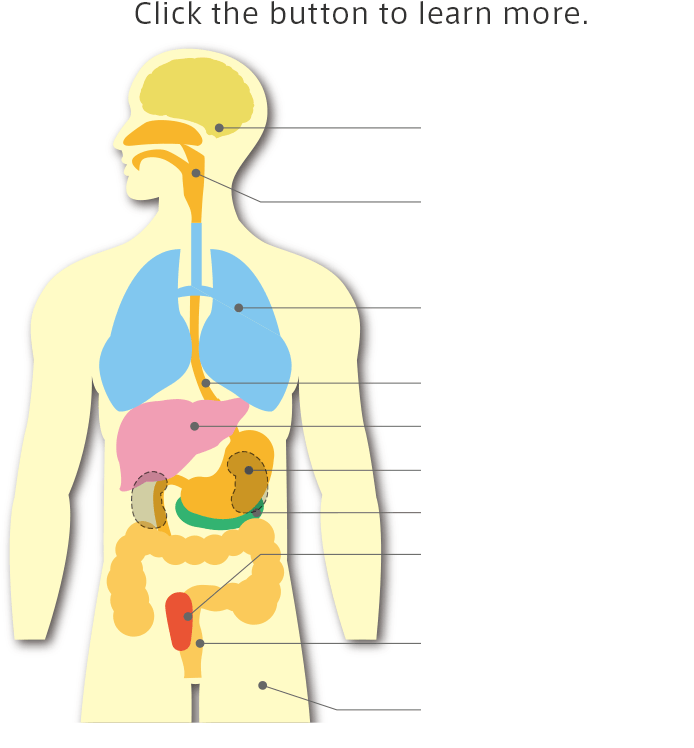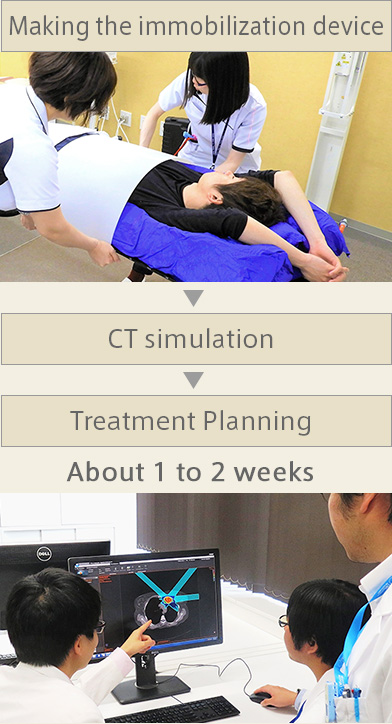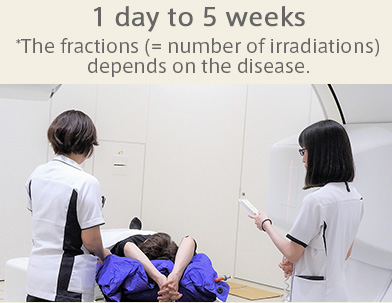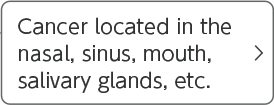Before patient referral
Osaka Heavy Ion Therapy Center provides only heavy ion therapy.
Medical treatment other than heavy ion therapy, including examinations for initial diagnosis of cancer, is not included in our services. Please consult your primary doctor.
General conditions
Since heavy ion therapy is less demanding on the body, it is a suitable treatment even for the elderly and those with chronic illness. However, please understand that it is necessary to satisfy the following conditions before this treatment can be applied. It is not a treatment method applicable to all disease conditions.
- ■The cancer is localized, and its treatment range is limited.
- ■The targeted treatment site has never received radiation therapy in the past.
- ■The patient can remain lying down for about 30 minutes. (guideline)
- ■The Performance Status (PS) at the start of treatment is in the range of 0-2 (KI 60 or more).
- ■There is no active and refractory infections in the irradiation area.
- ■The patient, noticed of the cancer selects heavy ion therapy of his/her free will.
Precautions / Notes
Heavy ion therapy is a treatment method expected to have high therapeutic performances with few side effects, but there is a possibility of recurrence as with other treatments.
In addition, not all cancers are treatable by heavy ion therapy. Adaptation for heavy ion therapy requires comprehensive judgment by medical specialists.
Even if it is seemingly a treatable disease, as a result of examination after the initial visit, it may be judged that it is not applicable for heavy ion therapy.
Also, even if all the conditions are met, there are cases where heavy ion therapy cannot be performed due to technical reasons.
Treatment policy / Eligibility condition
Heavy ion therapy conducted at our center is based on the unified protocol of the Japanese Society for Radiation Oncology (JASTRO). We have organized a working-group titled "Osaka Heavy Ion Therapy Study Working Group for each treatment lesion" consisting of specialists from Osaka International Cancer Institute, Osaka University, Osaka Medical College, Osaka City University, Kansai Medical University, Kindai University, and our own center. This group will analyse each case to perform heavy ion therapy. Please see the Japanese Society for Radiation Oncology (JASTRO) website for our current treatment policies and eligibility criteria for each lesion.
| Cancer | Pathologic classification |
|---|---|
| Head and neck tumor | Non-squamous cell carcinoma and lacrimal gland carcinoma |
| Head and neck malignant melanoma | |
| Head and neck squamous cell carcinoma (nonoperative nasal sinus cancer, hearing aid cancer) | |
| Urological tumor | Prostate cancer |
| Renal carcinoma | |
| Bone soft tissue tumor | Skull base tumor |
| Bone soft tissue tumor | |
| Head and neck soft bone tumor | |
| Pulmonary / mediastinal tumor | Localized lung cancer |
| Local non-small cell lung cancer | |
| Gastrointestinal tumor | Thoracic Esophageal Cancer (cT1N0M0) |
| Local recurrent rectal cancer | |
| Pelvic recurrence after colorectal cancer operation | |
| Hepatobiliary pancreatic tumor | Hepatocellular cancer |
| Intrahepatic cholangiocarcinoma | |
| Resectable pancreatic cancer (preoperative) | |
| Locally advanced pancreatic cancer | |
| Mammary gland / Gynecology | Locally advanced cervical cancer |
| Locally advanced endometrial cancer | |
| Gynecological area malignant melanoma | |
| Metastatic tumor | Metastatic lung tumor (3 or less) |
| Metastatic liver tumor (3 or less) | |
| Metastatic lymph node |
Cancers suitable for heavy ion therapy
Heavy ion therapy is suitable for localized solid cancer treatment.
It is a treatment that can also spare the normal tissues or organs at risk near the cancer.
*Note that the applicable sites may depend on the facility. Please contact the treatment facility for more details.

 Skull base tumors(number of treatment times: 16 times)
Skull base tumors(number of treatment times: 16 times)
What are skull base tumors?
The tumors that occur in the deepest part of the extracranial-intracranial area, and in the center of the head, are collectively called the skull base tumor. These tumors occurring in the deepest parts are often next to or adhere to many important nerves and major blood vessels. Therefore, surgery is difficult. Among the skull base tumors, there are radioresistance tumors.
Clinical conditions and requirements for heavy ion therapy
- ■In cases where surgery is impossible or the tumor cannot be completely removed by surgery.
- ■Primary skull base tumors (e.g. chordoma, chondrosarcoma) without lymph node metastasis and distant metastasis.
- ■Skull base tumor which is located upper than the second cervical vertebra.
- ■The tumor can be measured by CT and MRI.
Points of attention regarding heavy ion therapy
The beam direction is carefully selected so as to avoid the optic nerve and the brain stem as much as possible because skull base is where important nerves and organs are gathered closely.
Expected side effects
There is difference about the toxicities depend on each tumor location where is closed to the critical organs such as the brain, optic nerve or jawbone, so the possibilities of these toxicities will be explained at the consultation.
 Head and neck cancers(numbers of treatment times: 16 times)
Head and neck cancers(numbers of treatment times: 16 times)
What are head and neck cancers?
The head and neck are deemed as being the parts below the brain and above the clavicle, including the eyes, nose, mouth, ears and throat. It is said that about 5% of all cancers occur in the head and neck because head and neck contains many morphologically complex and important organs, and it is necessary to treat the cancer of each part in consideration to their characteristics.
Head and neck cancers are classified into the following; oral cancer, pharyngeal cancer, laryngeal cancer, paranasal sinus and nasal cavity cancer, salivary gland cancer, and thyroid cancer. Current treatment targets of heavy ion therapy are non-squamous cell carcinoma and lacrimal adenocarcinoma, head and neck mucosal malignant melanoma, and inoperable squamous cell carcinoma of the ear and nasal sinuses. Radiation therapy has the advantage of preserving function and form in the treatment of head and neck cancer. Heavy ion therapy also allows for localized irradiation of lesions, which may not only improve treatment outcome, but may also reduce the late effects of treatment. In addition, heavy ion therapy is said to be highly effective for cancerous types that are resistant to conventional radiation and chemotherapy.
The actual method of treatment depends on the location of the tumor, its pathological diagnosis, and its’ degree of progression. In some cases, a multidisciplinary treatment, which is a combination of surgery, radiation therapy and chemotherapy, may also be performed.
Clinical conditions and requirements for heavy ion therapy
- ■Head and neck non-squamous cell carcinoma or lacrimal gland tumor which is diagnosed histologically, inoperative head and neck mucosal malignant melanoma and choroidal malignant melanoma, and inoperative primary squamous cell carcinoma of the ear and nasal sinuses.
- ■In cases where there is no metastasis to other organs or lymph nodes, and all the lesions can be within one irradiation field. (N0M0 case, or N1M0 case in which lesions are within one irradiation field.)
- ■There is a measurable tumor on CT or MRI.
- ■Inoperable tumor, recurrence or residual tumor after surgery.
Points of attention regarding heavy ion therapy
Side effects depend on the site of the lesion and progress. Our doctor will explain in detail at the time of consultation.
Expected side effects
During treatment, adverse events may occur mainly in normal tissue such as skin, mucous membranes. (e.g. oral and pharyngeal mucositis, dermatitis, salivation disorder, otitis media, etc.) It is necessary to do the local observation for 2 to 4 weeks after treatment.
In addition, there is a risk of side effects such as optic neuritis, osteomyelitis, osteonecrosis, and muscle fibrosis depending on the treatment lesion. Those may occur 3 months or more after heavy ion therapy.
There is difference about the toxicities depend on each tumor location where is closed to the critical organs such as the brain, optic nerve or jawbone, so the possibilities of these toxicities will be explained at the consultation.
 Localized lung cancer(approximate number of treatment times: 1 to 16 times)
Localized lung cancer(approximate number of treatment times: 1 to 16 times)
What is lung cancer?
Lung cancer is cancerous cells of the bronchial and alveolar cells.
As it progresses, cancer cells proliferate, destroying surrounding tissue, and spread through the bloodstream and the lymphatic system. Lung cancer is likely to spread to lymph nodes, brain, liver, adrenals, and bones.
There are several types of lung cancer, depending on the form of the cancer cells. In the case of stage I non-small cell lung cancer that is localized in the lung, treatment by heavy ion therapy can be completed in about 1 week of outpatient visits.
Clinical conditions and requirements for heavy ion therapy
- ■Non-small cell lung cancer diagnosed by histology or cytology.
- ■Inoperable, or when the patient does not want surgery.
- ■Clinical stage I and cT2b-T3N0M0 (TNM classification 8th edition).
Points of attention regarding heavy ion therapy
In order to perform irradiation more precisely, there are cases when the position may be confirmed by in-room CT.
As with treatment of other areas, please keep in mind that smoking cessation is required during and after treatment.
Expected side effects
Adverse events may occur mainly in skin, chest wall / ribs, lung / bronchus, esophagus. (e.g. dermatitis, pneumonia, esophagitis, etc.)
 Locally advanced non-small cell lung cancer(number of treatment times: 16 times)
Locally advanced non-small cell lung cancer(number of treatment times: 16 times)
What is lung cancer?
Lung cancer is cancerous cells of the bronchial and alveolar cells. As it progresses, cancer cells proliferate, destroying surrounding tissue, and spread through the bloodstream and the lymphatic system. Lung cancer is likely to spread to lymph nodes, brain, liver, adrenals, and bones.
There are several types of lung cancer, depending on the form of the cancer cells. For locally advanced non-small cell lung cancer, treatment by heavy ion therapy can be completed on an outpatient basis in approximately 4 weeks.
Clinical conditions and requirements for heavy ion therapy
- ■Non-small cell lung cancer (Clinical stage II-III).
- ■There is no invasion into the heart, large blood vessels, trachea, esophagus.
- ■Chemotherapy can not be performed due to age or other reasons, or chemotherapy is refused by the patient.
Points of attention regarding heavy ion therapy
In order to perform irradiation more precisely, there are cases when the position may be confirmed by In-Room CT.
As with treatment of other areas, please keep in mind that smoking cessation is required during and after treatment.
Expected side effects
Adverse events may occur mainly in skin, chest wall / ribs, lung / bronchus, esophagus. (e.g. dermatitis, pneumonia, esophagitis, etc.)
 Esophageal cancer(approximate number of treatment times: 12 times)
Esophageal cancer(approximate number of treatment times: 12 times)
What is esophageal cancer?
Esophageal cancer is a malignant tumor that originates in the mucous membrane of the esophagus, and there are two main types - squamous cell carcinoma and adenocarcinoma. Squamous cell carcinoma originates from the epithelium on the surface of the lining of the esophagus. On the other hand, adenocarcinoma often occurs in the background of reflux esophagitis caused by gastric acid refluxing in the esophagus, accounting for more than half of esophageal cancer in the West. In Japan, over 90% of esophageal cancer is squamous cell carcinoma.
Heavy ion therapy can reduce side effects on the important organs such as the spinal cord, lungs and heart while maintaining the therapeutic effect on esophageal cancer.
Clinical conditions and requirements for heavy ion therapy
- ■Inoperable or surgical refusal cases (Stage I).
Points of attention regarding heavy ion therapy
It is necessary for the patient to avoid drinking alcohol for a certain period after heavy ion therapy.
The patient may be requested to attach a clip in the esophagus in order to allow the heavy ion beam to be administered with a higher precision.
Expected side effects
Dermatitis and esophagitis are side effects during treatment. In particular, radiation esophagitis can occur to a greater or lesser extent.
Side effects after treatment may include esophageal ulcers, esophageal strictures, esophageal perforations, radiation pneumonitis, cardiac dysfunction, and the like.
 Liver cancer(approximate number of treatment times: 2 to 4 times)
Liver cancer(approximate number of treatment times: 2 to 4 times)
What is liver cancer?
Liver cancer is roughly classified into “primary liver cancer” which occurs in the liver, and “metastatic liver cancer” which metastasized from another organ.
"Primary liver cancer" includes "hepatocellular carcinoma" in which the cells of the liver become cancer, and "cholangiocarcinoma" in which the cells of the duct which drains bile into the duodenum (bile duct) become cancer. In Japan, “hepatocellular carcinoma” accounts for 90% of “primary liver cancer”.
Most liver cancer (hepatocellular carcinoma) is due to chronic hepatitis and cirrhosis caused by hepatitis virus (type B and C) infection. Heavy ion therapy is a treatment that is highly effective because it irradiates cancer intensively so its damage to the normal liver is small. Therefore, the deterioration of liver function is difficult to occur. Because of long-standing hepatitis and liver cirrhosis, the liver itself is predisposed to develop cancer. Consequently, it may cause new cancer at other sites, and it is necessary to follow up after treatment by a specialist.
Clinical conditions and requirements for heavy ion therapy
- ■Diagnosed histologically or clinically as hepatocellular carcinoma (HCC) or intrahepatic cholangiocarcinoma.
- ■Hepatic function is maintained to some extent. (Child-Pugh classification is A or B)
- ■There is no metastasis to other organs, and it is a focal lesion (with a diameter of 12 cm or less).
- ■There is no digestive tract near the tumor.
- ■Untreated, or one month or more has passed since the previous treatment for the treatment target lesion, and the residual or recurrence has been confirmed on the image.
Points of attention regarding heavy ion therapy
In order to perform irradiation more precisely, gold marker of several millimeters may be inserted into the liver. The use of gold markers will be decided after consultation with our doctor, your primary doctor, and the doctor of the relevant medical institution.
Expected side effects
Adverse events may occur in the skin / subcutaneous tissue, ribs, gastrointestinal tract, liver function. (e.g. dermatitis, gastrointestinal bleeding, rib fracture, etc.)
 Renal cancer(approximate number of treatment times: 12 times)
Renal cancer(approximate number of treatment times: 12 times)
What is renal cancer?
Among the cancers appearing in the kidney, renal cell carcinoma is the one whose cells in the kidney parenchyma have become cancerous and malignant. Even if the cancer appears in the same kidney, cancerous cells in the renal pelvis are called "renal pelvis cancer" and are distinguished from renal cell carcinoma. Renal cell carcinoma and renal pelvis carcinoma differ in the nature of their cancers, and respective methods of treatment. Generally, "renal cancer" refers to renal cell cancer.
Clinical conditions and requirements for heavy ion therapy
- ■Diagnosed histologically or clinically as renal cell carcinoma.
- ■Renal function on the healthy side should be maintained to some extent.
- ■There is no metastasis to other organs, and it has a focal lesion.
- ■There is no digestive tract near the tumor.
Points of attention regarding heavy ion therapy
In order to perform irradiation more precisely, gold marker of several millimeters may be inserted into the kidney.
In similar reason, there are cases when the position may be confirmed by In-Room CT.
Expected side effects
Adverse reactions may appear on the skin and abdominal wall, gastrointestinal tract, liver function, pancreas, and kidney. Blood toxicity, loss of appetite, gastrointestinal ulcer / bleeding, hematuria and intratumoral infection are predicted as adverse events.
 Pancreatic cancer(approximate number of treatment times: 12 times)
Pancreatic cancer(approximate number of treatment times: 12 times)
What is pancreatic cancer?
More than 90% of cancers that occur in the pancreas can be in the cells of the pancreatic duct. This is called pancreatic duct cancer, and pancreatic cancer usually refers to this pancreatic duct cancer.
In the case of heavy ion therapy for locally advanced pancreatic cancer, chemotherapy using Gemcitabine or TS-1 is generally used in combination.
Clinical conditions and requirements for heavy ion therapy
- ■Invasive pancreatic ductal carcinoma of the clinical stage I, IIA, IIB, III (The 8th edition of the UICC TNM Classification) which has been diagnosed by histopathology or images. (Note 1)
- ■Judged inoperable for reasons such as, being in a particular stage or complications.
- ■The functions of the main organs remain maintained.
- ■The tumor is not close to the digestive tract.
- ■There is no gastroduodenal ulcer (except for ulcer scars).
- ■There is no metal stent placement in the bile ducts. (If required, replace it with a plastic stent.)
- Note 1: It is desirable that the cancer have been histopathologically diagnosed.
Points of attention regarding heavy ion therapy
In order to perform irradiation more precisely, markers of several millimeters may be inserted into the pancreas. The use of gold markers will be decided after consultation with our doctor, your primary doctor, and the doctor of the relevant medical institution.
Expected side effects
Adverse reactions may appear on the skin and abdominal wall, gastrointestinal tract, liver function, pancreas, and biliary tract. Blood toxicity, loss of appetite, gastric ulcer/bleeding, intratumoral infection and stenosis of bile duct are predicted as adverse events.
 Locally advanced cervical cancer(approximate number of treatment times: 20 times)
Locally advanced cervical cancer(approximate number of treatment times: 20 times)
What is cervical cancer?
The majority of gynecological cancers are uterine cancers which include cervical cancer and uterine body cancer. Uterine body cancer, also known as endometrial cancer, originates from the endometrium inside the endometrial area that raise the fetus. On the other hand, cervical cancer originates from the cervix at the entrance of the uterus. As it often occurs near the entrance of the uterus, it can be said that cervical cancer is easy to be observed and inspected through an ordinary gynecological examination. It is relatively easy to treat and has a good prognosis if it is detected early, but will be difficult if progressed.
Clinical conditions and requirements for heavy ion therapy
- ■Histologically diagnosed with adenocarcinoma or adenosquamous cell carcinoma or squamous cell carcinoma.
- ■FIGO clinical stage IIA-IIIB.
- ■In the case of squamous cell carcinoma, the tumor diameter is 6cm or more. (Note 1)
- ■There is no lymph node enlargement of more than 1cm in diameter in the abdominal para-aortic region when observed by an abdominal CT.
- ■No medical history of surgery or chemotherapy.
- Note 1: There is no lower limit for tumor size in adenocarcinoma or adenosquamous cell carcinoma.
Points of attention regarding heavy ion therapy
In order to perform irradiation more precisely, patients may be asked to control defecation and urination.
Expected side effects
Mainly appear in the organs in the irradiated area, which are the bladder, urethra, and rectum. Side effects include frequent urination, hematuria, and melena.
 Prostate cancer(approximate number of treatment times: 12 times)
Prostate cancer(approximate number of treatment times: 12 times)
What is prostate cancer?
Prostate cancer is caused by cells in the prostate losing normal cell proliferative function and proliferating randomly. Prostate cancer can often be treated successfully if it is discovered early. Usually prostate cancer grows relatively slowly. It often metastasizes to nearby lymph nodes and bones, but may metastasize to the lungs, liver, etc.
Clinical conditions and requirements for heavy ion therapy
- ■T1c-T3N0M0 (no organ metastasis, no lymph node metastasis). Or primary prostate cancer of T4 (bladder neck invasion) N0M0.
- ■The Gleason Score is clear by histopathological examination.
- ■The PSA test prior to prostate biopsy is clear.
- ■Prostate cancer is classified into low, middle and high risk groups depending on the condition of the lesion. In the case of middle and high-risk groups, it is required to combine treatment with hormonal therapy.
Points of attention regarding heavy ion therapy
In order to perform irradiation more precisely, gold markers of several millimeters may be inserted into the prostate. The use of gold markers will be decided after consultation with our doctor, your primary doctor, and the doctor of the relevant medical institution.
In the intermediate-risk group, heavy ion therapy is given after 0 to 6 months of hormone therapy. In the high-risk group, heavy ion therapy will be given after 6 months of hormone therapy, in addition, hormone therapy will be continued for 1 and a half years after heavy ion therapy. Hormone therapy be performed by your primary doctor's instructions.
Expected side effects
Mainly appear in the organs in the irradiated area, which are the bladder, urethra, and rectum. Side effects include frequent urination, hematuria, and melena.
 Rectal cancer (pelvic recurrence)(approximate number of treatment times: 16 times)
Rectal cancer (pelvic recurrence)(approximate number of treatment times: 16 times)
What is rectal cancer?
Colorectal cancer occurs in the large intestine which is about 2m in length and made up of the cecal, colon and rectum. And the study shows that the Japanese are prone to cancer in the sigmoid colon and rectum.
Colorectal cancer originates from the cells of the colonic mucosa. One type is a part of a benign polyp which is called adenoma and becomes cancerous, and the other develops directly from normal mucosa. It develops from the surface of the mucous membrane and invades the wall of the large intestine gradually and metastasizes to other organs such as lymph nodes, the liver and lungs as it progresses.
Clinical conditions and requirements for heavy ion therapy
- ■Recurrent lesions which localize in the pelvis that is histologically or clinically diagnosed after primary colorectal cancer resection.
- ■No obvious recurrent lesion outside the pelvis.
- ■Cases where a curative resection for recurring lesions is not applicable or the patient does not want to have surgery.
- ■Main organ function is maintained.
- ■The tumor is not close to the digestive tract.
- ■It is not an anastomotic recurrence.
- ■There are no open wounds or active and intractable infections in the irradiation area.
Points of attention regarding heavy ion therapy
In order to perform irradiation more precisely, there are cases when the position may be confirmed by in-room CT.
If the tumor is close to the digestive tract, an absorbable spacer may be inserted. The spacer insertion will be decided after consultation with our doctor, your primary doctor, and the doctor of the relevant medical institution.
Expected side effects
Adverse reactions mainly occur in skin, urinary tract, nerve, bone, digestive tract, etc. which is contained in the treatment area. Intractable ulcer and bleeding may appear in the tissue near the tumor.
 Bone and soft tissue tumors(approximate number of treatment times: 16 times)
Bone and soft tissue tumors(approximate number of treatment times: 16 times)
What are bone and soft tissue tumors?
Bone and soft tissue tumors are a general term for bone tumors, which generated from bones, and soft tissue tumors, which generated from soft tissues such as muscles, fats, nerves and blood vessels, etc.
Primary malignant bone and soft tissue tumors are also referred to as "bone and soft tissue sarcomas" . As the typical disease names, chordoma, osteosarcoma and liposarcoma are given.
Sarcomas occur in various parts of the body, including the limbs, torso, head and neck, and in the retroperitoneum.
Clinical conditions and requirements for heavy ion therapy
- ■Histologically diagnosed primary malignant bone and soft tissue tumor (Note 1) or, its tumor equivalent (Note 2).
- ■N0M0 case.
- ■The tumor can be measured.
- ■Non-adaptation of radical resection. (Cases judged by specialists to be radically inoperable, or if the patient refuses a resection.)
- ■Pretreatment-postoperative recurrence is treatable. Chemotherapy patients should have a 2-week interval before the start of heavy ion therapy.
- ■There are no metal fixtures affecting treatment planning (dose planning) in the irradiation area.
- Note 1: Non-epithelial malignancy arising from bones, joints and soft tissues all over the body, e.g. osteosarcoma, chondrosarcoma, MFH, MPNST, synovial sarcoma, liposarcoma, leiomyosarcoma, etc.
- Note 2: E.g. chordoma, recurrent osteoblasts, desmoid etc.
Points of attention regarding heavy ion therapy
If there are metal fixtures in the irradiation area, some or all of them may be removed so as not to affect treatment planning (dose planning).
If the tumor is close to the digestive tract, an absorbable spacer may be inserted. The spacer insertion will be decided after consultation with our doctor, your primary doctor, and the doctor of the relevant medical institution.
Expected side effects
Adverse reactions mainly occur in normal tissue (skin, nerves, bones, etc.) contained in the treatment area, and in organs (e.g. digestive tract) near the tumor.
 Lymph node metastasis(approximate number of treatment times: 12 times)
Lymph node metastasis(approximate number of treatment times: 12 times)
What are lymph node metastasis?
Lymph node metastasis of gastrointestinal cancer, lung cancer, esophageal cancer, gynecologic cancer, and so on.
Clinical conditions and requirements for heavy ion therapy
- ■Less than 3 lymph node metastases from gastrointestinal cancer, lung cancer, esophageal cancer or gynecologic cancer. The metastases of the lymph nodes include deep cervical lymph node, thoracic lymph node, abdominal lymph node, and pelvic lymph node. The lymph node metastases which should be contained in one irradiation field.
- ■Surgery and radiation therapy are performed on the primary site, and there is no recurrence or residual lesion.
- ■There is no other metastasis.
Points of attention regarding heavy ion therapy
In order to perform irradiation more precisely, there are cases when the position may be confirmed by in-room CT.
If the tumor is close to the digestive tract, a spacer may be inserted. The spacer insertion will be decided after consultation with our doctor, your primary doctor, and the doctor of the relevant medical institution.
Expected side effects
Adverse reactions mainly occur in normal tissue (skin, nerves, bones, etc.) contained in the treatment area, and in organs (e.g. digestive tract) near the tumor.
■Approximate number of fractions and period for treatment
| Types of cancer | Number of fractions | Treatment period |
|---|---|---|
| Skull base cancer | 16 | 4 weeks |
| Head and Neck cancer | 16 | 4 weeks |
| Lung cancer | 1〜4 | Within 1 week |
| Esophageal Cancer | 12 | 3 weeks |
| Liver cancer | 2〜4 | Within 1 week |
| Kidney cancer (Renal cancer) | 12 | 3 weeks |
| Pancreatic cancer | 12 | 3 weeks |
| Uterine cancer | 20 | 5 weeks |
| Prostate cancer | 12 | 3 weeks |
| Local recurrence of rectal cancer | 16 | 4 weeks |
| Bone & soft tissue cancer | 16 | 4 weeks |
| Lymph node metastasis | 12 | 3 weeks |
Some of the information listed above is based on clinical trials. In addition, the cancer that can be treated depends on the facility. Please contact the treatment facility for more details.
Flow from consultation to treatment
Reservation required.
You must have a reservation, no walk-ins accepted.
Patients
Please consult your doctor if you wish to receive heavy ion therapy treatment.
Medical institution
Patients need to prepare medical information such as a referral letter attention to Osaka Heavy Ion Therapy Center, medical image data and various examination results.
The “Patient referral documents” means referral letter, medical image data (CT/MRI/RI/PET-CT) in CD-R showing chronological change, blood test data showing the transitions of tumor marker and urea nitrogen and creatinine, pathological findings, respiratory function test results, etc.
Patients
Agent
(medical tourism company)
Osaka Heavy Ion
Therapy Center
We will notify of treatment applicability through our medical tourism agents.
If heavy ion therapy is applicable, we will inform of the scheduled appointment details through our medical tourism agents.
Patients will prepare for the consultation through our medical tourism agents.
Agent
(medical tourism company)
Patients
Travel to Japan
Osaka Heavy Ion
Therapy Center
- Consultation

At the medical examination, we check the patient's condition from clinical information such as the referral letter, medical image data and various examination results.
As a result of examination, the suitability of heavy ion therapy will be determined.
- Preparation for heavy ion therapy

We prepare for accurate irradiation before treatment. In order to keep the patient’s body fixed during irradiation, a patient-specific immobilization device will be made. With this device attached, the patient is put in position for CT imaging necessary for treatment planning. Based on the CT image data, radiation oncologists, medical physicists and other medical staff will cooperate and make a treatment plan, by entering the position and shape of the target cancer in the computer dedicated to the treatment planning, determining the angle of the irradiation beam, the dose (= amount of irradiation), fractions (= number of irradiations), etc. to consider the optimal irradiation method.
- Heavy ion therapy

Heavy ion therapy is performed according to the treatment plan. Prior to irradiation every time, patient positioning is strictly performed. After the patient positioned on the couch and confirmed the irradiation site by X-ray imaging, the heavy ion beam will be irradiated.
- Patient follow-up

After heavy ion therapy is completed, we will provide medical follow-ups such as physical exam, blood tests, CT or MRI in cooperation with the patient’s primary doctor. The patient is to visit our center every three months for consultations to check the condition in reference to the medical examinations by the primary doctor’s medical care. We continue to observe the progress of the patient’s condition for five years after the heavy ion therapy, giving the patient necessary advice from the viewpoint of heavy ion therapy. Continuous follow-up is recommended to evaluate side effects of heavy ion therapy on a long-term basis and to ensure that there is no recurrence.












